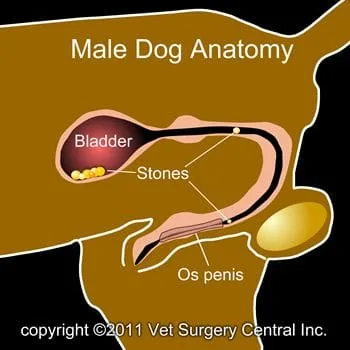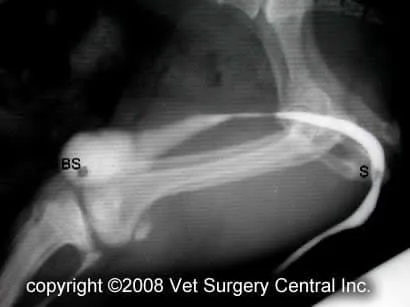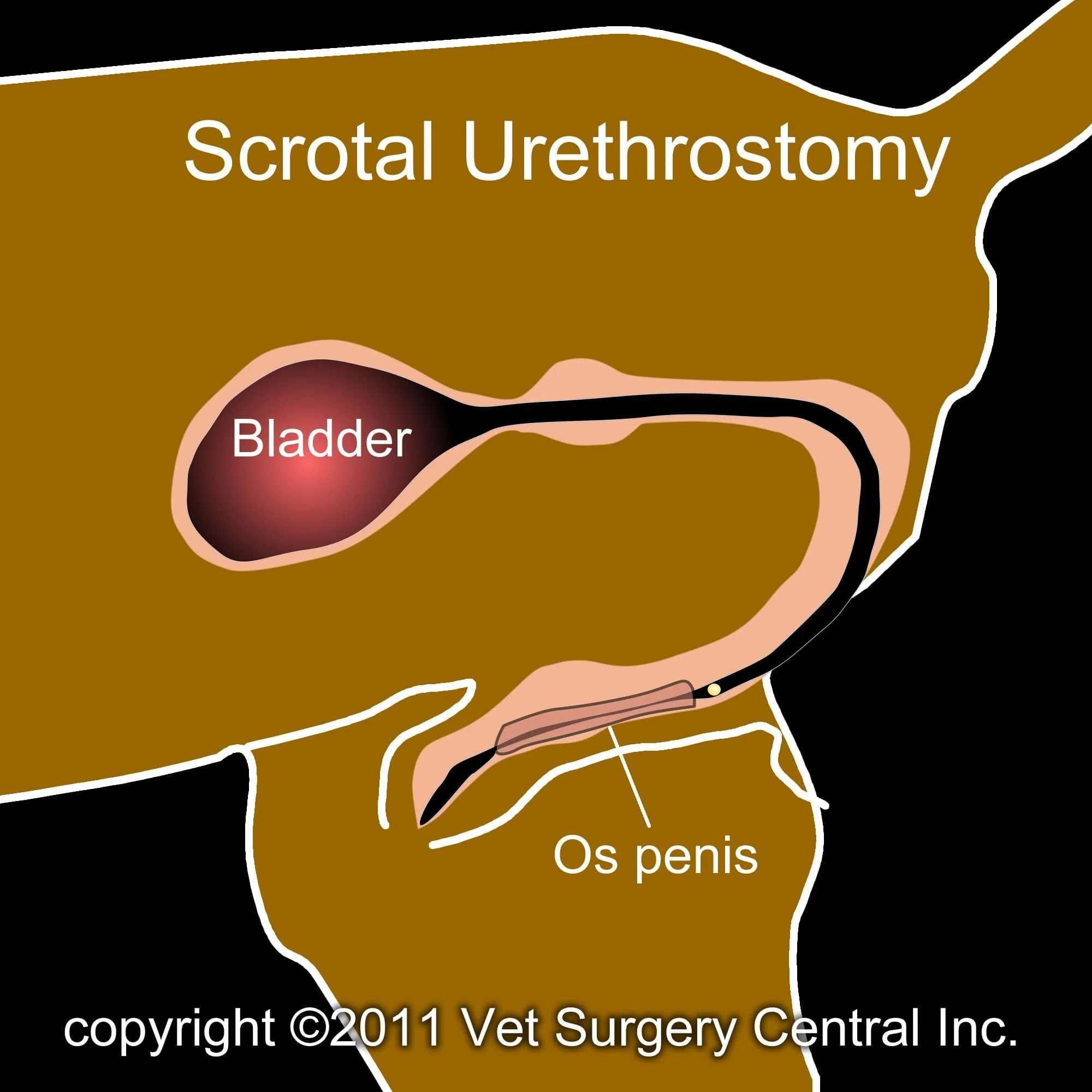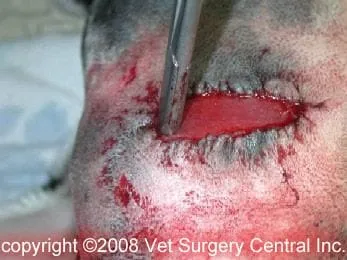Key Points
Urethrostomy is a useful procedure to bypass the penile urethra, when a disease such as a stricture, stone or tumor is preventing urination
Urethrostomy is most commonly used in male dogs that have developed urinary blockage multiple times
In some cases the urethrostomy usually is a permanent and is not reversed
Prognosis usually is good, but the pet must be observed for urinary tract infections

The urinary system is made of the kidneys, the tubes (ureters) that pass urine from the kidneys to the bladder, the bladder which is a reservoir for urine, and the urethra, which is the tube that drains urine from the bladder to the outside. The urethra in males is fairly long and a portion of it runs through the tissue of the penis. In dogs the penis has a bone (os penis) that surrounds the urethra for part of its length. The diameter of the urethra narrows as it passes through the os, therefore stones frequently get lodged in this region.
What is an urethral obstruction?
A stone may pass into the urethra from the bladder, thus cause obstruction to urinary flow. The result is that the dog cannot urinate. This problem is most commonly seen in male dogs due to the narrowing of the urethra at the os penis (see illustration below right and endoscopic photo of the urethra at the level of the os penis). Following obstruction to urinary flow, toxins build up in the body as urine cannot be excreted. Within 24 hours of obstruction, the dog will be very ill and can die.

Cancer of the penis – although uncommon, may require amputation of the penis and urethrostomy surgery.
Trauma to the penis or urethra may necessitate amputation of the penis and scrotal urethrostomy surgery
Bladder stones, if small enough may pass from the bladder into the urethra. Frequently the stones will get stuck in the urethra at the level of the os penis. Sometimes these stones cannot be flushed back into the bladder or have caused too much trauma to the urethra. When a pet cannot urinate it is very painful and toxins that are normally excreted in the urine accumulate in the body. After a couple of days the pet will die due to a build up of toxins and electrolyte abnormalities. Below is a dye study of a dog that is having difficulty urinating; take not of the stone out lined by dye in the urethra (S) and in the bladder (BS); the dye is white and the stones are dark gray.
Urethrostomy
Urethrostomy usually is done to provide a new opening, through which the pet can urinate. Urethrostomy by definition means creating an opening in the urethra. This opening may be made as a temporary measure or it may be permanent. The urethrostomy can be made in a couple of different locations. In dogs the urethrostomy is usually made at the level of the scrotum. As a result, if the pet is not neutered, this will need to be done at the time of the urethrostomy. Dogs having an urethrostomy will urinate between the legs and usually will squat to urinate, like a female dog. In the photo below illustrates a urethrostomy site; an instrument is placed in the opening where urine flows out (for demonstration purposes)


Potential complications
Even though rare, anesthetic death can occur. With the use of modern anesthetic protocols and extensive monitoring devices (blood pressure, EKG, pulse oxymetry, inspiratory and expiratory carbon dioxide levels, and respiration rate), the risk of problems with anesthesia is minimal.
Recurrent bladder infections can occur due to infection ascending up the urethra
Stricture of the urethrostomy site can occur if the urethra has been badly damaged. In this situation the urethrostomy site closes down as the tissues heal and the pet will then have difficulty urinating. If stricture formation of the urethrostomy site has not occurred by 6 weeks after surgery, then it is not likely to occur.
Bleeding bright red blood from the urethrostomy site after surgery is very common, as the urethra has a very robust blood supply. Excitement and urination will cause the bleeding to start up. Dogs usually bleed more than cats. The urethrostomy site may bleed a lot, but do not be alarmed unless the gums are getting pale pink or if your pet is weak or depressed. Tranquilization may be needed to keep your pet calm until the site has healed well. Children or infant diapers can be used to minimize the mess from the bleeding. By 10 days after surgery, the bleeding should stop.
Straining to urinate may be a recurrent clinical sign and usually is due to a problem with the bladder (inflammation or infection) and not the urethra.
Suggested reading
Degner, DA. Procedures Pro: Urinary obstruction: treatment measures. Clinicians Brief. 9(9):70-75, 2011. (click here); please note that Clinicians Brief is the publisher and copyright holder of this article and they have given permission (11/2911) to share it on www.vetsurgerycentral.com.
rev 12/1/11


